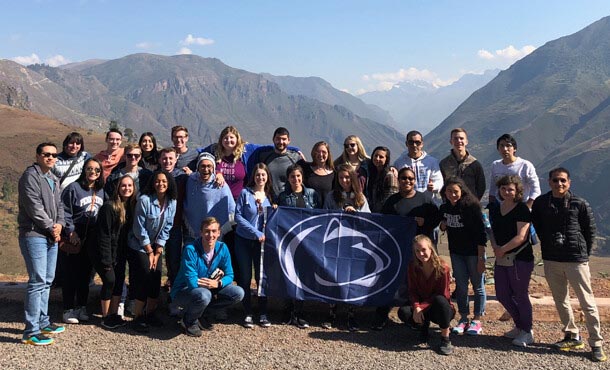
With the help of a recent NSF grant, Penn State researchers will take undergraduate students from around the country to Peru over the summer to study extreme weather events near the Peruvian Andes and in the Peruvian Amazon. IMAGE: PROVIDED BY JULIO URBINA
Collaborative climate project provides research opportunities to undergrads
9/17/2021
By Sarah Small
UNIVERSITY PARK, Pa. — Julio Urbina, associate professor of electrical engineering at Penn State, can sum up the issue of climate change succinctly: “We saw the latest (Intergovernmental Panel on Climate Change) report, and it said time is up.” The solutions, however, are more nuanced and will require a multi-disciplinary approach to be effective, Urbina said.
This was the focus when Urbina and other researchers put together a program for U.S. undergraduate students to research extreme weather events and climate change in Peru. The team includes researchers from electrical engineering, civil and environmental engineering, meteorology and sociology.
The program began with Research Opportunities for mid-Career Knowledge EnhancemenT (ROCKET) seed funding from the Penn State College of Engineering and seed funds from the Penn State Office of Global Programs, and it recently was awarded a three-year, $300,000 National Science Foundation grant. It will recruit undergraduate students from around the country with an emphasis on underrepresented and low-income students as well as those at universities that offer fewer research opportunities. Each summer, five of these students will travel to Peru with the researchers for eight to nine weeks to study extreme weather events near the Peruvian Andes and in the Peruvian Amazon.
According to Rachel Brennan, associate professor of civil and environmental engineering, her involvement in the project dates back to the summer of 2019, when she, Urbina, and other colleagues traveled to Peru to co-teach a cross-cultural engagement and science, technology, engineering and mathematics (STEM) course. That same year, she was asked by the Center for Global Engineering Engagement to coordinate the program around a common theme of sustainable development.
“We were building our Drawdown Scholars Research Experiences for Undergraduates program at Penn State at the same time, and I saw potential links between the two,” Brennan said. “I was excited to frame strategies for solving site-specific, water-energy-food nexus challenges in Peru within the broader context of reversing global warming. So, we tried it, and it was a huge success! The projects the students completed that summer were inspiring and motivated us to grow the program.”
Brennan and Urbina brought in several other colleagues from across Penn State to provide different perspectives from their respective fields.
“This collaboration started, for me, as a way to develop atmospheric and climate research in Peru, where we have such strong contrasts between the Pacific Ocean on the west and the Amazon rainforest region on the east with the Andes Mountains in the middle,” said collaborator Chris Forest, professor of climate dynamics and associate director of the Network for Sustainable Climate Risk Management. “These make the area very interesting for understanding the weather and climate across the country as a whole. Ideally, we want to develop both modeling and observational tools for assessing how regional weather conditions influence the ecosystems that impact both the hydrology and the biogeochemistry in the region.”
According to Urbina, the locations were selected not only for their unique weather and climate events but also because they are areas where remote sensing techniques alone cannot be relied on for accurate data collection.
“The instrumentation part — the electrical engineering part — is a main component of this project,” Urbina said. “We will show the students how to look into the power consumption, how to integrate the sensors we’d like to mount on drones, how to do signal analysis. If the electrical engineering part doesn’t work, nothing else will work.”
Forest and Brennan will work with Alfonso Mejia, associate professor of civil and environmental engineering, to analyze and model the data that will be provided through the electrical engineering components. Jose Fuentes, professor of meteorology, serves as senior personnel on the project and, according to Urbina, provides encouragement, mentorship and insights to bring the project to fruition. Meanwhile, Heather Randell, assistant professor of rural sociology and demography, will lead the efforts to provide a social science perspective, giving the research a holistic view.
“My main research goal for this project is to work collectively with undergrads to better understand how households in different regions of Peru are experiencing climate change, and what steps they have taken to adapt to the effects of climate change,” Randell said. “My main teaching and mentoring goal is to introduce undergrads to qualitative social science data collection and analysis methods and to teach them to think about climate change through a sociological lens.”
The researchers said they hope to collect and analyze both the environmental and sociological data as well as use their findings to expand the research efforts.
“We want to study how the heterogeneity and biodiversity of the rainforest contributes to the fluxes of water, energy, carbon and other components, and, in turn, this will establish records that can improve satellite measurements in other parts of the Amazon where we don’t have in-situ observational data,” Forest said. “This will help us trust that the satellites are providing accurate data in other regions.”
The program plans to provide both research and mentoring opportunities to the undergraduate students. According to Urbina, if the program is successful, they would like to replicate this program as a model for other universities.
“I’m looking into piloting these programs because they can be scaled up and are transferrable not just to U.S. institutions but also in other parts of the world,” he said.



